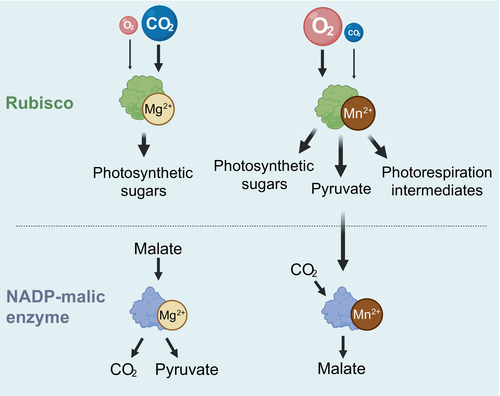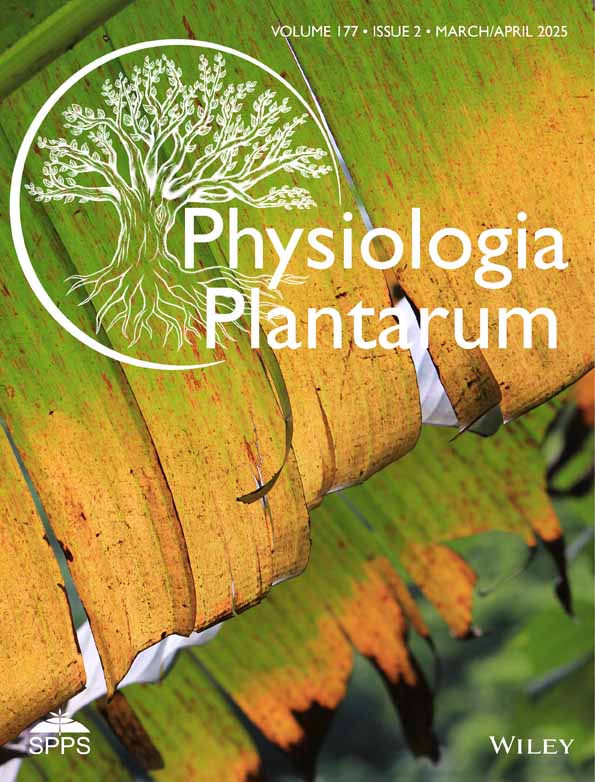In the Spotlight: The unexpected protagonists that shape plant survival
Linked article: this spotlight refers to Shi et al. (2024). To view this article, please visit https://doi.org/10.1111/ppl.14463.
Plants are masters of adaptation, constantly adapting their metabolism to thrive in changing environments. A new study by Shi et al. (2024) reveals how two unassuming metals, magnesium (Mg2+) and manganese (Mn2+), act as molecular switches, influencing the most important enzyme on Earth, Rubisco. When Mg2+ is present, Rubisco fuels photosynthesis, but when Mn2+ takes over, plants redirect carbon into alternative pathways that help them cope with stress. This ancient survival trick, dating back over two billion years, still shapes plant metabolism today. Understanding how plants control these metals could unlock new strategies for engineering climate-resilient crops and securing our food supply in an unpredictable world. Sometimes, the smallest elements hold the biggest secrets (Figure 1).

Magnesium (Mg2+) and manganese (Mn2+) act as metabolic switches, guiding the activity of two key chloroplast enzymes: Rubisco and NADP-malic enzyme.
Top Panel (Rubisco Activity): Rubisco's function depends on which metal it's working with. When Mg2+ is in control (left side), Rubisco efficiently fixes CO₂, fueling photosynthesis and sugar production through the Calvin-Benson-Bassham cycle. But if Mn2+ takes over (right side), the enzyme shifts gears, increasing its preference for O₂ over CO₂. This leads to two possible outcomes: the production of pyruvate, which feeds into other metabolic pathways like malate synthesis, or photorespiratory intermediates, which demand extra energy to recycle.
Bottom Panel (NADP-Malic Enzyme Activity): Like Rubisco, NADP-malic enzyme also changes its role depending on its cofactor. With Mg2+ (left side), it focuses on breaking down malate to release CO₂ and pyruvate, which drive photosynthesis and energy production. But when Mn2+ is in charge (right side), the enzyme flips its function, using pyruvate to build malate—an essential metabolite for nitrogen assimilation and redox balance. Figure generated with Biorender.
Imagine a world where plants, the silent architects of our ecosystem, are secretly fine-tuning their metabolism, adapting to environmental changes with the help of unexpected allies: metals. Magnesium (Mg2+) and manganese (Mn2+) might not sound like protagonists in a high-stakes survival story, but they are. When Mg2+ is bound to Rubisco, the enzyme responsible for photosynthesis, plants efficiently fix carbon and fuel sugar production. But when Mn2+ steps in, it's like flipping a metabolic switch. Rubisco shifts gears, prioritizing pathways that help plants handle stress. It's a biochemical balancing act, with plants strategically deciding when to accelerate photosynthesis and when to detour toward survival mode. A recent study by Shi et al. published in Physiologia Plantarum reveals how plants use these metals as molecular levers to switch between different metabolic strategies, optimizing their energy use in response to fluctuating conditions (Shi et al., 2024). And if we understand this biochemical balance, we might unlock new ways to engineer crops that thrive in an unpredictable climate.
How do we know all this? Shi et al. didn't just assume plants were playing this metal-swapping game, they put it to the test. Using Arabidopsis thaliana, a model plant species, the researchers ran biochemical assays, tracking how Rubisco behaves when different metals are in charge. The results? When Mg2+ was present, Rubisco stuck to its classic role, capturing CO₂ and fueling photosynthesis. But when Mn2+ took over, the enzyme pivoted toward oxygenation, increasing photorespiration and rerouting carbon into malate and pyruvate. To confirm these findings outside the lab, the team used gas exchange measurements and chlorophyll fluorescence imaging, monitoring how living plants dynamically adjusted their metabolism based on metal availability. The main takeaway here is that plants aren't just passive players in their environment—they are making strategic biochemical choices in real-time.
But wait, where did this trick come from? It turns out swapping metals isn't just a modern-day survival hack—it's an ancient one. Over two billion years ago, during the Great Oxidation Event, Earth's oxygen levels skyrocketed, forcing early photosynthetic organisms to evolve new ways to cope. Mn2+ played a starring role in this adaptation, becoming essential in Photosystem II, where plants split water molecules to release oxygen (Fischer et al., 2016; Lingappa et al., 2019). Fast forward to today, and Mn2+ is still pulling strings behind the scenes, helping plants adapt to fluctuating CO₂ levels, nutrient imbalances, and environmental stress. And it is not just Rubisco feeling the effects. Shi et al. found that Mn2+ also alters the function of the plastidic malic enzyme, a key player in carbon and nitrogen metabolism. To see this in action, the researchers used stable isotope labelling to trace carbon movement in plants exposed to different Mn2+: Mg2+ ratios. When Mn2+ was abundant, plants ramped up malate production, a process crucial for nitrogen assimilation and stress resistance. But when Mg2+ levels were higher, plants redirected carbon toward pyruvate and energy production. This flexibility allows plants to adjust their metabolism like a thermostat, optimizing for growth when conditions are good and switching to survival mode when resources are scarce.
So, why should we care about a tiny metal shuffle happening inside plants? Because understanding this biochemical flexibility could change the way we approach agriculture. Imagine engineering crops that can actively adjust their metal usage to thrive in tough conditions. By fine-tuning Mg2+ and Mn2+ availability, scientists could develop plants that flourish in nutrient-poor soils, resist extreme weather, and maintain high yields despite environmental stress.
The next step? Exploring how this metal-switching mechanism operates across different plant species and ecosystems. Could tropical crops make better use of Mn2+ in nutrient-deficient soils? Could this knowledge lead to crops that use nitrogen more efficiently, reducing fertilizer dependency? As researchers dig deeper, they may uncover even more hidden metabolic pathways shaped by these tiny but mighty elements. The smallest players in plant metabolism might just hold the biggest secrets for the future of agriculture and sustainability.
FUNDING INFORMATION
This work was supported by the University of Florida CALS Dean's Award to N.P.




